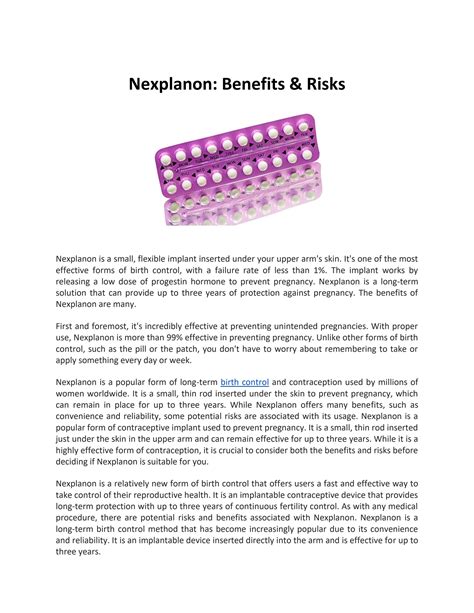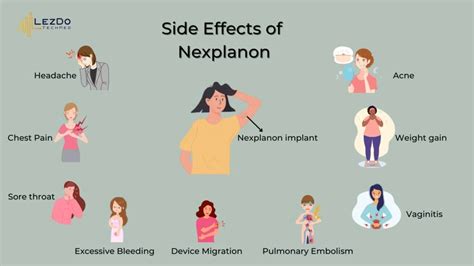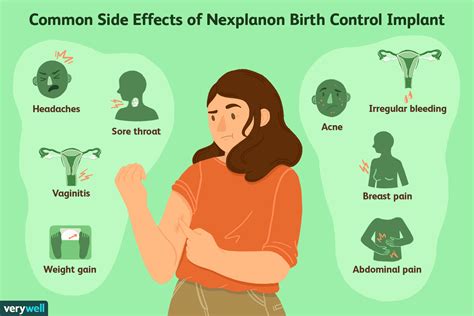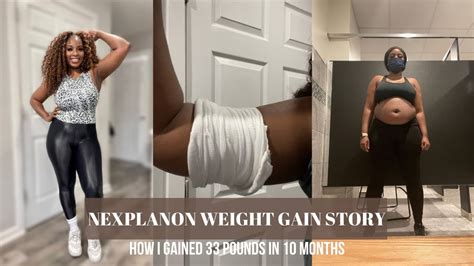Intro
Nexplanon birth control works effectively, offering a hassle-free, long-term contraceptive solution with high efficacy, low maintenance, and minimal side effects, making it a popular choice for women seeking reliable hormonal implant birth control methods.
The world of birth control has seen numerous advancements over the years, with various methods being developed to cater to different needs and preferences. One such method that has gained popularity is the Nexplanon birth control implant. This small, flexible rod is inserted under the skin of the upper arm, releasing a steady dose of hormones to prevent pregnancy. But how does it work, and what are its benefits and potential side effects?
The Nexplanon implant is a type of long-acting reversible contraceptive (LARC) that contains etonogestrel, a form of progestin. This hormone helps to prevent pregnancy by thickening the cervical mucus, making it difficult for sperm to reach the egg. It also prevents ovulation, which means that there is no egg released from the ovaries to be fertilized. Additionally, the hormone causes the lining of the uterus to thin, making it less likely for a fertilized egg to implant.
Nexplanon Benefits

The Nexplanon implant has several benefits that make it a popular choice among women. One of the main advantages is its high effectiveness rate, with a failure rate of less than 1%. This means that out of every 100 women who use the implant, less than one will become pregnant. The implant is also easy to use, as it requires no daily maintenance or pill-taking. Once it's inserted, it can remain in place for up to three years, providing continuous protection against pregnancy.
Another benefit of the Nexplanon implant is its reversibility. If a woman decides that she wants to become pregnant, the implant can be removed, and fertility will return quickly. In fact, studies have shown that women who have used the Nexplanon implant are just as likely to become pregnant as those who have not used any form of birth control. The implant is also a good option for women who have trouble remembering to take daily pills or use other forms of birth control.
How Nexplanon Works
The Nexplanon implant works by releasing a steady dose of etonogestrel into the bloodstream. This hormone is slowly released over time, providing continuous protection against pregnancy. The implant is inserted under the skin of the upper arm, where it remains in place for up to three years. During this time, the hormone helps to prevent pregnancy by:- Thickening the cervical mucus, making it difficult for sperm to reach the egg
- Preventing ovulation, which means that there is no egg released from the ovaries to be fertilized
- Causing the lining of the uterus to thin, making it less likely for a fertilized egg to implant
Nexplanon Side Effects

While the Nexplanon implant is generally well-tolerated, there are some potential side effects to be aware of. These can include:
- Irregular bleeding or spotting, which can occur in the first few months after insertion
- Breast tenderness or swelling
- Headaches or migraines
- Mood changes, such as depression or anxiety
- Weight gain or loss
- Acne or skin changes
It's worth noting that these side effects are usually mild and temporary, and they may resolve on their own over time. However, if you experience any severe or persistent side effects, you should speak with your healthcare provider.
Nexplanon Insertion and Removal
The Nexplanon implant is inserted under the skin of the upper arm, using a small needle and a special inserter. The procedure is usually quick and painless, and it can be performed in a healthcare provider's office. The implant is inserted just under the skin, where it remains in place for up to three years.When it's time to remove the implant, the procedure is also relatively quick and easy. The healthcare provider will use a local anesthetic to numb the area, and then make a small incision in the skin to remove the implant. The procedure is usually painless, and it can be performed in a healthcare provider's office.
Nexplanon Effectiveness

The Nexplanon implant is highly effective in preventing pregnancy. In fact, it has a failure rate of less than 1%, which means that out of every 100 women who use the implant, less than one will become pregnant. This makes it one of the most effective forms of birth control available.
The implant is also effective in reducing the risk of unintended pregnancy. Studies have shown that women who use the Nexplanon implant are less likely to experience an unintended pregnancy than those who use other forms of birth control. This is because the implant provides continuous protection against pregnancy, without the need for daily maintenance or pill-taking.
Nexplanon and Fertility
One of the benefits of the Nexplanon implant is its reversibility. If a woman decides that she wants to become pregnant, the implant can be removed, and fertility will return quickly. In fact, studies have shown that women who have used the Nexplanon implant are just as likely to become pregnant as those who have not used any form of birth control.This is because the implant does not affect the ovaries or the uterus in any way that would prevent pregnancy. Instead, it simply provides a steady dose of hormones that help to prevent pregnancy. Once the implant is removed, the hormones are no longer present, and fertility returns to normal.
Nexplanon and Weight

Some women may experience weight changes while using the Nexplanon implant. This can be due to the hormones released by the implant, which can affect appetite and metabolism. However, the weight changes are usually mild and temporary, and they may resolve on their own over time.
It's worth noting that the Nexplanon implant is not a weight loss method, and it should not be used for this purpose. Instead, it is a form of birth control that provides effective protection against pregnancy. If you experience any significant weight changes while using the implant, you should speak with your healthcare provider.
Nexplanon and Breastfeeding
The Nexplanon implant is safe to use while breastfeeding. In fact, it is one of the few forms of birth control that is recommended for breastfeeding women. This is because the implant does not affect milk production or the quality of breast milk.However, it's worth noting that the implant should not be inserted until at least six weeks after giving birth. This allows the uterus to return to its normal size and reduces the risk of complications during insertion.
Nexplanon and Mental Health

Some women may experience mood changes while using the Nexplanon implant. This can include depression, anxiety, or irritability. However, these side effects are usually mild and temporary, and they may resolve on their own over time.
If you experience any significant mood changes while using the implant, you should speak with your healthcare provider. They can help you determine the cause of the mood changes and recommend treatment options.
Nexplanon and Acne
The Nexplanon implant can affect acne in some women. This is because the hormones released by the implant can affect the oil glands in the skin, leading to acne or skin changes. However, the acne is usually mild and temporary, and it may resolve on its own over time.If you experience any significant acne or skin changes while using the implant, you should speak with your healthcare provider. They can help you determine the cause of the acne and recommend treatment options.
Nexplanon and Headaches

Some women may experience headaches while using the Nexplanon implant. This can be due to the hormones released by the implant, which can affect blood vessels and neurotransmitters in the brain. However, the headaches are usually mild and temporary, and they may resolve on their own over time.
If you experience any significant headaches while using the implant, you should speak with your healthcare provider. They can help you determine the cause of the headaches and recommend treatment options.
Nexplanon and Sex Drive
The Nexplanon implant can affect sex drive in some women. This is because the hormones released by the implant can affect libido and arousal. However, the changes in sex drive are usually mild and temporary, and they may resolve on their own over time.If you experience any significant changes in sex drive while using the implant, you should speak with your healthcare provider. They can help you determine the cause of the changes and recommend treatment options.
Nexplanon and Pregnancy

The Nexplanon implant is designed to prevent pregnancy. However, if you do become pregnant while using the implant, it's essential to speak with your healthcare provider. They can help you determine the best course of action and provide guidance on prenatal care.
It's worth noting that the Nexplanon implant does not increase the risk of birth defects or complications during pregnancy. However, it's essential to follow the recommended insertion and removal procedures to minimize the risk of complications.
Nexplanon and Ectopic Pregnancy
The Nexplanon implant can reduce the risk of ectopic pregnancy. This is because the implant helps to prevent pregnancy altogether, reducing the risk of ectopic pregnancy. However, if you do experience any symptoms of ectopic pregnancy, such as severe abdominal pain or vaginal bleeding, you should seek medical attention immediately.What is the Nexplanon implant?
+The Nexplanon implant is a small, flexible rod that is inserted under the skin of the upper arm, releasing a steady dose of hormones to prevent pregnancy.
How effective is the Nexplanon implant?
+The Nexplanon implant is highly effective, with a failure rate of less than 1%. This means that out of every 100 women who use the implant, less than one will become pregnant.
Can I use the Nexplanon implant while breastfeeding?
+Yes, the Nexplanon implant is safe to use while breastfeeding. In fact, it is one of the few forms of birth control that is recommended for breastfeeding women.
How long does the Nexplanon implant last?
+The Nexplanon implant can last for up to three years. After this time, it will need to be removed and replaced with a new implant if you wish to continue using it as a form of birth control.
Can I remove the Nexplanon implant myself?
+No, the Nexplanon implant should only be removed by a healthcare provider. They will use a special procedure to remove the implant, and they can also provide guidance on what to expect during the removal process.
In conclusion, the Nexplanon implant is a highly effective and convenient form of birth control that provides continuous protection against pregnancy. While it may have some potential side effects, these are usually mild and temporary. If you're considering using the Nexplanon implant, it's essential to speak with your healthcare provider to determine if it's the right choice for you. They can help you weigh the benefits and risks and provide guidance on insertion, removal, and any potential side effects. We hope this article has provided you with a comprehensive understanding of the Nexplanon implant and its uses. If you have any further questions or concerns, please don't hesitate to reach out to us. Share this article with your friends and family to help them make informed decisions about their reproductive health.
